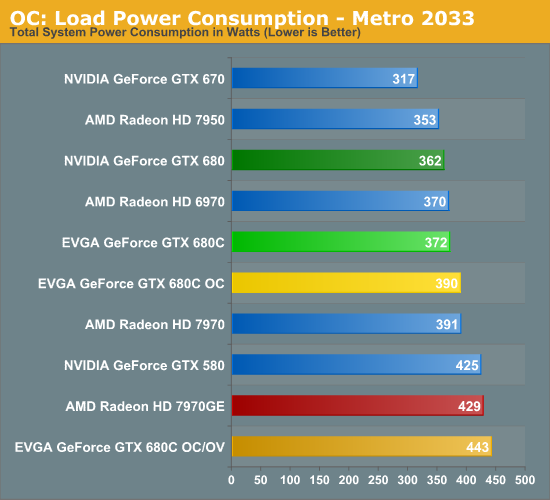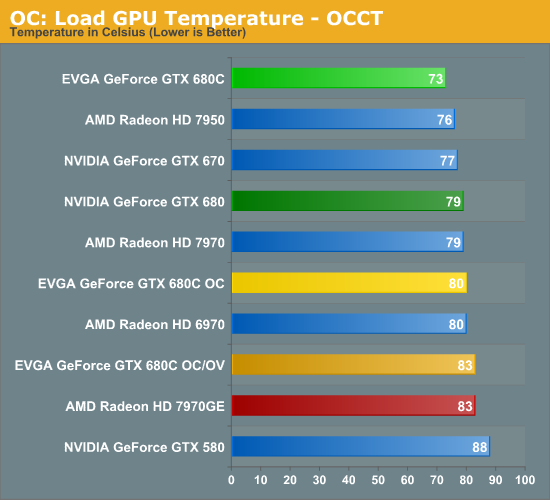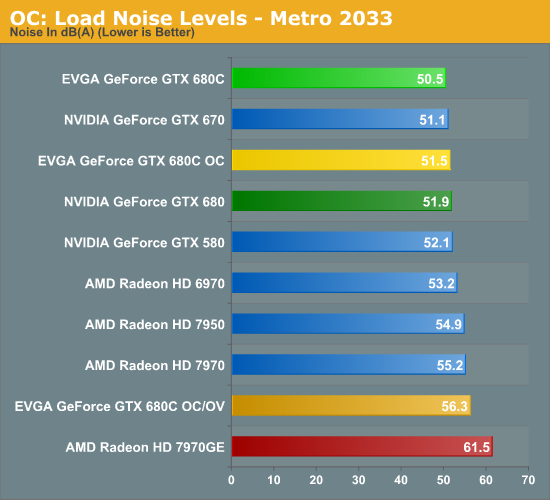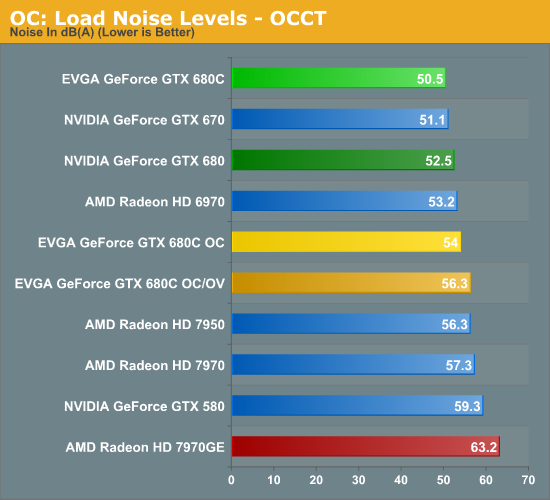EVGA GeForce GTX 680 Classified Review: Pushing GTX 680 To Its Peak
by Ryan Smith on July 20, 2012 12:00 PM ESTOverclocked: Power, Temperature, & Noise
So far our look at the stock performance of the GTX 680 Classified has been more obligatory than critical. The GTX 680 Classified is first and foremost an overclocking card, and while EVGA ships it with a decent factory overclock it’s the end-user overclock that is going to make the GTX 680 Classified stand apart from the crowd.
So how did the GTX 680 Classified fare? As always, we’re going to break our results down into two categories. We’ve overclocked our sample both with and without overvolting it, to get an idea of just how much more headroom is left in the GK104 GPU at stock, and how much more headroom is unlocked through overvolting.
| EVGA GTX 680 Classified Overclocking | |||||
| Stock | OC | OC + OV | |||
| Core Clock | 1111MHz | 1211MHz | 1287MHz | ||
| Max Boost Clock | 1201MHz | 1301MHz | 1377MHz | ||
| Memory Clock | 6GHz | 6.4GHz | 6.5GHz | ||
| Max Boost Voltage | 1.175v | 1.175v | 1.275v | ||
Without overvolting we were able to push our GTX 680 Classified an additional 100MHz(9%) on the core to 1211MHz. Given that we started with what was already a factory overclocked GPU, the fact that this is nearly 100Mhz beyond our next best card should come as no surprise. Binning doesn’t just isolate GPUs that can reach EVGA’s stock specifications, but it isolates those GPUs that can overclock better than the rest too.
Meanwhile on the memory front we were only able to push the memory a further 400MHz to 6.4GHz. This is noticeably less than what we’ve been able to push reference-based GTX 670/680 cards (which have reached nearly 7GHz), and it’s not immediately clear why we’re seeing this difference. With both a custom PCB and additional memory chips it’s possible that either one could be holding back memory overclocking, or more likely it’s a combination of the two. Regardless of the reason this does put the GTX 680 Classified in a bit of a bind, since the GTX 680 is no stranger to memory bandwidth starvation.
As for the impact of overvolting, unfortunately as it turns out overvolting didn’t greatly improve our results. With a core voltage of 1.275v (0.1v over stock) we were able to hit a base clock of 1286MHz, which is just 75MHz higher than what we hit on the stock voltage of 1.175v. In fact both in absolute and relative terms we gained more from our initial stock voltage overclock than we did from the overvolting overclock. Which is not to say that overvolting doesn’t help – clearly it does – but in our limited experience overvolting isn’t unlocking any kind of amazing clockspeed. It’s merely pushing GK104 a bit higher than it can go on stock voltage.
Memory overvolting doesn’t have a particularly great impact either. With a memory voltage of 1.65v we were able to squeeze out another 100MHz with the GTX 680 Classified’s 4GB of GDDR5. Much like the core overclock this is an improvement, but not greatly so.
Ultimately overvolting the GTX 680 Classified most certainly improves its overclockability, but at least on air you won’t be hitting any obscene clocks. Even then we don’t seem to be particularly temperature limited, so it’s not clear whether better (but not extreme) cooling would improve our overclocking results.
But before we jump into our results, there’s one more thing to take into consideration: that pesky power target. EVGA does have a higher power target, but even at 300W+ when using an increased power target, overvolting is going to quickly vault you towards it. The end result is that too much overvolting can make things slower, or at the very least limit the performance gains of what’s already a limited clockspeed increase.
The solution to this is EVGA’s BIOS switch, which effectively removes all of the power limits for the card, but this is not something to be used carelessly. Based on our temperature results with the stock BIOS there’s still some headroom, but the fact that this switch is labeled “LN2” is telling. Disabling all of the power limits is probably not a good idea on the reference cooler, at least in our conservative opinion.
So now that we’ve gone over overclocking in detail, what has it done for power temperature and noise? Let’s find out.


Starting as always with power consumption, as to be expected the impact of overclocking on power consumption varies wildly with whether we’re overvolting. Without overvolting our overclock pushes power consumption at the wall up by 18W in Metro, and a much more significant 49W with OCCT (though do keep in mind that we’ve also raised our power target to +132%). At least as far as games go, without a voltage increase the overall increase in power consumption is fairly small.
Pouring on the voltage significantly increases the power consumption however in both Metro and OCCT. With Metro our power consumption is now 443W at the wall, and with OCCT that’s 425W. This isn’t to say that the overvolting wasn’t worth it, but that additional 75MHz on the core clock and 100MHz memory clock has come with a significant cost.


As to be expected, load temperatures end up reflecting our power consumption figures. Without overvolting we see a 1C increase under Metro and a 7C increase under OCCT. Overvolting pushes the GTX 680 Classified over 80C in all circumstances, topping out at 83C with OCCT. At only 83C there’s still some thermal headroom to play with here for overclocking, but at 1.275v we’re approaching the safe & sane limits for GK104. Users looking to push the voltage harder will want better cooling, but even better cooling may not be enough in the long-run.


Finally we have our look at load noise. Without overvolting we see the overclocked GTX 680 Classified hit 51.5dB, which incredibly enough is still a smidge quieter than the reference GTX 680. For those of you looking for a fairly quiet overclocking card, the GTX 680 Classified is starting to look very good.
As for overvolting, in both Metro and OCCT cause our sample card to hit 56.3dB. This is understandably louder than the reference GTX 680 at this point, though in absolute terms whether it’s particularly loud or not depends on what you’re willing to put up with. The consolation prize here is that even with overclocking and overvolting it’s still 5dB+ quieter than the reference 7970GE.










75 Comments
View All Comments
plonk420 - Saturday, July 21, 2012 - link
i'm kinda more interested in 8xMSAA or 4xSSAA...Ryan Smith - Saturday, July 21, 2012 - link
Ahh, okay, I see what you mean.So the short answer is that the memory requirements on Ultra are so high that we wouldn't be able to test most of our previous-generation 1GB cards at 1920 if we used it. I did want to have Ultra in there somewhere so that was the compromise I had to make to balance that with the need for a useful test at 1920.
Though I will agree that it's unorthodox.
RussianSensation - Saturday, July 21, 2012 - link
At the same time that would be pretty useful to see if GTX570/580 run out of VRAM in Shogun with Ultra settings at 1080P. What if GTX660Ti only has 1.5GB of VRAM? We'd want to know if it's already starting to become a bare minimum in games :)CeriseCogburn - Tuesday, July 24, 2012 - link
The 570 and 580 don't run out, but the 5750, 5870, and 6950 1gb and 6970 1gb do. A lot of amd fans have those 1gb cards because as usual, the amd fan is all about scrimping pennies and claiming they have the best anyway. Sad, isn't it.Sadder is the 1920x1200 rez they use here, which allows crap amd cards to lose by less when most people have 1920x1080 where nVidia stomps on amd ever harder, because as usual, amd fan boys are hacking away over pennies and buy the much cheaper and far more common 1920x1080 monitors instead of 1920x1200, saving $50 minimum amd more like $100+.
So, amd loses, all around, again, as usual.
Sabresiberian - Sunday, July 22, 2012 - link
There is no "1200p"Catch-phrases like "720p" and "1080p" refer to television formats; they aren't just the vertical pixel number. 1920x1200 is not a television standard, and the "p" is superfluous.
;)
LtGoonRush - Friday, July 20, 2012 - link
While EVGA's cooler is an improvement over stock, I wonder how a capable card like this would perform if paired with an high performance cooler like the Arctic Accelero Xtreme III. Kepler-based cards drop their boost clocks above 70C to compensate for increased leakage, so it would be interesting to see how fast this card could get while staying below that mark. Even at maximum RPMs the fans would probably be quieter than this one.pandemonium - Saturday, July 21, 2012 - link
I can't understand where the market for this card is. Wait, nevermind. I forgot how many nVidia fanbois there are out there...RussianSensation - Saturday, July 21, 2012 - link
So true. $740 GTX680 with a volt-mod kit vs. $450 HD7970 that overclocks on stock voltage to 1.175V and gives the same performance. NV marketing machine FTW!CeriseCogburn - Tuesday, July 24, 2012 - link
Amd cards never give the same performance as they lack so many features.you can perhaps, if you're lucky, get an fps only equivlanet in a few old games, or a hacked equivalent with crappy IQ that I'm sure you cannot see anyway, and in that case your power/performance is a big fat loser too - we cannot suddenly forget that for just this latest round when it was the most important point ever made for several years just prior now can we...
pffffft !~
ypsylon - Saturday, July 21, 2012 - link
Not with this card. When you buy reference for liquid cooling then you can't go wrong with EVGA. Best cards around. When you buy EVGA Hydrocopper - you can't go wrong. But EVGA Classified are usually only highly overpriced reference designs. Yes there are tweaks here and there, but for max performance [air cooler] out of GTX family most people [including my humble person] go to MSI TwinFrozr3 Lighting/EX.or Asus 3 slot bricks (name escapes me).Lately EVGA sliding with theirs top offerings. SR-X motherboard is cruel joke when compared to ASUS dual CPU creation and now this. Another misfire.
But I think EVGA doesn't care too much. They have devoted customers who buy everything EVGA without thinking...